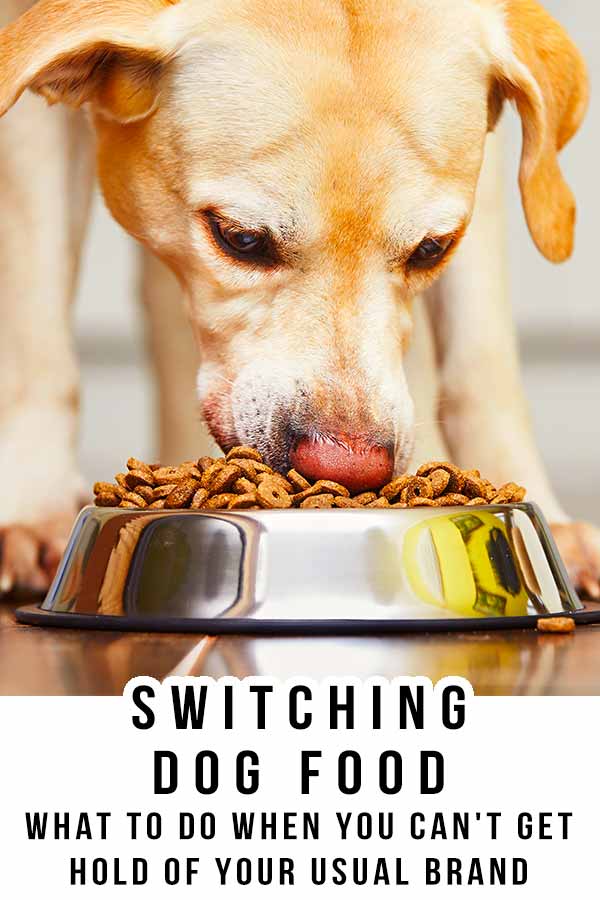Switching dog food doesn’t have to be a stressful experience. Whether you are changing the brand of food you use, or transitioning dog food from puppy to adult. The best method is to gradually change food over the course of a week. Slowly add in the new food, and reduce the proportion of old food, until you are only feeding your new dog food.
Reasons for switching dog food can vary, but the method will stay the same. Let’s take a closer look at why you might want to change dog food, and how best to do it.
Switching Dog Food – Contents
- Reasons to switch dog food
- When to switch to adult dog food
- When to switch to senior dog food
- How to choose a dog food
- How to change dog food
- Spotting food allergies and reactions
You can click on the links above if you’re looking for some specific information. Or, keep scrolling for a look at everything.
Reasons to Switch Dog Food
There are loads of reasons that you might need to switch dog food. They can relate to your dog’s health or age. Or, it could be to do with the availability of your old dog food brand. No matter what the reason, the process stays the same. But, before we go into that, let’s take a closer look at why you might need to change dog food.
1. Switching to Adult or Senior Food
One of the main reasons people need to change their dog food relates to the age of their dog. Puppies need a very different blend of nutrients to adult dogs. They need plenty of protein and fats in order to help their development and growth. You may also want to change their diet when you bring them home for the very first time.
Senior dogs can struggle with problems such as sensitive stomachs. The right dog food can soothe problems like this, and also provide supplements to help with painful joints. So, when your puppy reaches its fully grown size, it will need to transition to adult food. And, as your dog gets into his senior years, you may need to transition to a specially designed senior dog food.
2. Allergies
Another key reason to change dog food is if your pooch is suffering from an allergic reaction. Food allergies can develop in dogs at any age, so you might start having problems with a food that has been absolutely fine until now. Although your vet might provide ways to soothe the symptoms of food allergies, changing food to eliminate the problem ingredient is the only way to solve the allergy. This might involve some trial and error to identify which ingredient your dog is allergic to. But, you still need to transition dog foods slowly.
3. Brand Availability
Another issue that can affect people more often than you might think is brand availability. It’s possible for dog food recipes to be discontinued. Brands can also change their pricing all the time. So, you might find that continuing with the same dog food isn’t feasible, affordable, or even possible. It’s important to try and anticipate this change before you run out of the old food, if possible, so you can make the necessary change gradually.
4. Weight Management
If your dog is struggling to gain enough weight, or perhaps needs to lose some weight, your vet might suggest a new type of dog food. Dogs who need to put on weight are often given high protein, high calorie foods. Whereas dogs that need to lose weight are often given ‘diet’ dog foods. Either way, you would need to transition slowly to their new food.
When to Switch to Adult Food
An important milestone for every puppy is transitioning to adult dog food. However, this doesn’t happen at the same time for every dog. Dog breeds mature at different rates. Small dogs will grow to their full size a lot faster than large or giant dog breeds. Where it might only take 9 months for a small dog breed to mature fully, giant breeds can take up to three years. You can read more about puppy growth schedules here.
It’s important not to change to adult food too soon, as puppies need a unique blend of nutrients. So, if you’re unsure about when your dog will be a fully grown adult, the best person to speak to is your vet.
When to Switch to Senior Dog Food
This is another change that has quite a lot of variation depending on your dog breed. It’s hard to know exactly how long individual dogs will live – so most people tend to go by averages. Large dog breeds tend to have much shorter lifespans than small dog breeds. So, the age at which they might switch to senior food will differ. Again, the best person to speak to about this change is your vet. But, you may want to consider switching to senior food when your dog starts to slow down a little. Or if they are having any trouble with digestion and joint problems.
How to Choose a Dog Food
Switching dog food isn’t always an easy process. Some people don’t even know what type of dog food to change to at first. There is so much choice out there, it can be quite overwhelming. The best way to choose a new food is to think about the individual needs of your dog. Think about their age, and any health problems they have. If you’re changing brands because of financial or access reasons, you can try to find a food that is similar to the one you are already using.
Check the Ingredients
When switching dog food, choose a new option by taking a close look at the ingredients. If your dog has trouble with his joints, look for supplements like glucosamine and chondroitin. Alternatively, if your dog suffers from allergies, you might want to consider a limited ingredient food. Or, a natural dog food. Make sure to research any ingredients you aren’t sure about, so you know exactly what you’re feeding to your dog.
Check Reviews
Another great way to choose a new dog food is to look at reviews from other people. These can often be filtered so you can view the newest, and most relevant ones, first. You might find reviews from people who have the same dog breed as you. Many people also post photos that might help you finalize your decision.
Speak to your Vet
If you’re still struggling to choose a new dog food, the best person to speak to is your vet. This is because they can assess your dog’s individual needs and suggest ingredients that will be right for your pup.
How to Change Dog Food
Learning how to switch dog food is actually quite simple. Just remember – this is a gradual process. Changing dog food abruptly can cause digestive upset for your dog. This can result in symptoms such as vomiting and diarrhea. This will be just as unpleasant for you as it is for your dog! So, stagger your change over the course of a week. Here is a step by step guide to switching dog food.
Day 1 and 2
Don’t change the amount of food your dog eats when switching dog food. Instead, you need to change the ratio of new and old food. On the first and second days, give your dog a mixture of 75% old food brand, and 25% new food brand.
Day 3 and 4
On the third and fourth days, you will slightly increase the amount of new food you are giving your dog. At this stage, you will be feeding his new and old foods in equal amounts. So, 50% old diet, and 50% new diet.
Day 5 and 6
In these two days, your dog will be eating more of his new food than his old food. Give only 25% old food brand and 75% of his new food brand.
Day 7
From day 7 onwards, your dog will be eating 100% his new food.
Importance of Gradual Changing
If you switch dog food too quickly, you can risk causing your dog digestive upset. In fact, 7 days could be too fast for dogs who suffer from sensitive stomachs. A gradual change will give your dog plenty of time to adjust to his new diet. If you think your dog isn’t adjusting well to the change, you may be going too quickly. But, if you have transitioned very slowly and your dog is still displaying worrying symptoms, speak to your vet. The new food brand may just not agree with him.
Spotting Food Allergies and Reactions
It’s important to watch for symptoms that your dog’s new food isn’t agreeing with him. If you change to your new food very gradually and still notice these symptoms, you should consult with your vet. Here are some to look out for:
- Nausea and vomiting
- Diarrhea
- Loss of appetite
- Itching and irritation
- Skin inflammation
- Hair loss
- Rashes
Combating Allergies
If your vet thinks that your dog is allergic to one of the ingredients in the new food brand, they may suggest an elimination diet trial. They are likely to prescribe a hypoallergenic dog food diet to see if your dog’s symptoms disappear. At the end of this period, they may also try to reintroduce certain ingredients. This can help you discover exactly what ingredient it is that’s causing a problem for your dog.
Switching Dog Food Summary
So, switching dog food isn’t as complicated as it might seem! The most important tips when learning how to change dog food is to take things slowly. You should take at least 7 days to change to your new food brand. So, don’t wait until your old dog food runs out to make the change. If you change too quickly, your dog can experience digestive upset, which can be unpleasant for both of you.
If you’ve ever had to change dog food brands before, we would love to hear about your experiences. Why did you have to make the switch?
Related Articles
- Best Dog Food For Sensitive Stomach Issues
- Best Dog Food For Skin Allergies
- Feeding Your Labrador Puppy: How Much, Diet Charts And The Best Food
- Diabetic Dog Food
- What Can Dogs Not Eat?
References and Resources
- Tiffany, S. (et al), ‘Assessment of Dog Owners’ Knowledge Relating to the Diagnosis and Treatment of Canine Food Allergies’, The Canadian Veterinary Journal (2019)
- Lewis, T. ‘Diagnosing Food Allergies in Dogs and Cats: Bringing Your Case to Trial’, DVM 360 (2017)
- Bhagat, R. (et al), ‘Food Allergy in Canines: A Review’, Journal of Entomology and Zoology Studies (2017)
- Barnette, C & Ward, E. ‘Allergies in Dogs’, VCA (2018)
- Adams, V. (et al), ‘Methods and Mortality Results of a Health Survey of Purebred Dogs in the UK’, Journal of Small Animal Practice (2010)
The Labrador Site Founder
Pippa Mattinson is the best selling author of The Happy Puppy Handbook, the Labrador Handbook, Choosing The Perfect Puppy, and Total Recall.
She is also the founder of the Gundog Trust and the Dogsnet Online Training Program
Pippa's online training courses were launched in 2019 and you can find the latest course dates on the Dogsnet website




















Can I feed banana for lab 2 months old